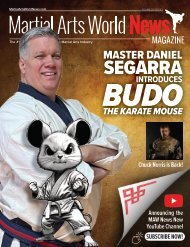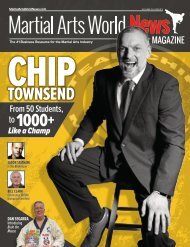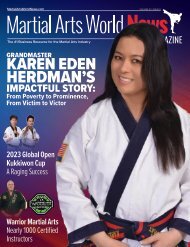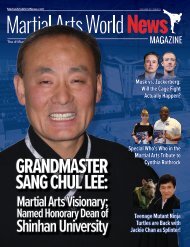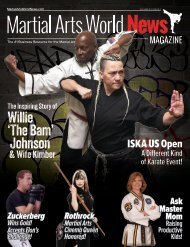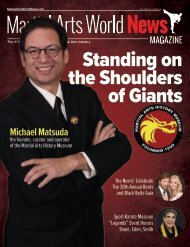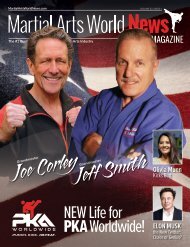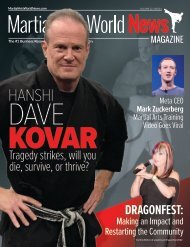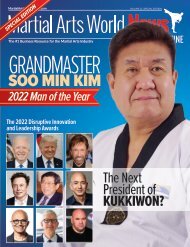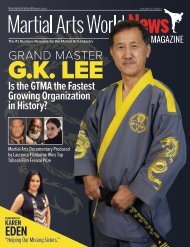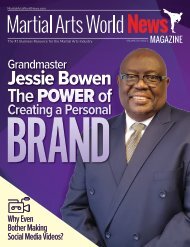Martial Arts World News Magazine - Volume 22 | Issue 3
The #1 Business Resource for the Martial Arts Industry
The #1 Business Resource for the Martial Arts Industry
Create successful ePaper yourself
Turn your PDF publications into a flip-book with our unique Google optimized e-Paper software.
INSTRUCTIONAL EXCELLENCE<br />
The Value of Stretching<br />
by Grandmaster Tim McCarthy<br />
Do you have your students stretch at the beginning of classes?<br />
Perhaps you have a warm-up routine for the beginning of each<br />
class. If you don’t, you might consider adding one.<br />
There are many values to a good warm-up. First of all, you<br />
literally warm-up your students’ bodies. They go from a state of<br />
calm to a state ready for action. You increase their blood flow,<br />
heart rate, and body temperature to prepare them for the strenuous<br />
activities in class. Without a warm-up you risk unnecessary<br />
injury. The warm-up is also a good time for some basic conditioning<br />
like push-ups, sit-ups, etc. to develop body strength. Most<br />
beginners need some conditioning, and more advanced students<br />
can benefit from advanced conditioning. Finally, stretching<br />
can be included to prevent injury and, if done properly, to<br />
increase flexibility.<br />
Stretching is also a great way to develop confidence<br />
because it develops bravery. Now, I want<br />
to distinguish right here the difference between<br />
stretching and loosening-up. I have known<br />
some very flexible people who never stretch.<br />
They plop down into a front split or a side split,<br />
then stand up and begin to do amazing kicks.<br />
To me, that’s not stretching; that’s loosening-up.<br />
Both are good, but there is a difference.<br />
Stretching hurts. Loosening-up doesn’t hurt.<br />
Stretching involves extending your muscle<br />
to its limit, where it hurts. At that point,<br />
your natural tendency is to back off.<br />
It doesn’t take a rocket scientist to<br />
know that if something hurts, you<br />
stop. A martial artist knows that<br />
sometimes pain is the price of<br />
progress, and stretching is an<br />
easy way to not only learn, but<br />
practice that principle. Pain is<br />
an important component.<br />
As you lead your students<br />
through a stretching<br />
session, first make sure<br />
they have warmed-up<br />
sufficiently. Cold muscles do not stretch easily nor do they<br />
stretch as far as warm muscles. When stretching to develop<br />
bravery, I recommend showing your students proper form and<br />
then encouraging them to stretch to the point where the muscle<br />
hurts. Some simple guidelines to use are (1) light muscle pain is<br />
OK, but intense muscle pain is not. Don’t be stupid and pull a<br />
muscle to show how brave you are. (2) Light muscle pain means<br />
you are stretching the muscle, but joint pain usually means you<br />
are damaging the joint. Avoid joint pain. (3) Don’t bounce. Move<br />
slowly and deliberately.<br />
As you are at the point where the muscle hurts, simply stay<br />
there for about 30 seconds or so. You will probably notice that<br />
if you don’t back away from the pain, the pain backs away from<br />
you. Your muscles will stretch a little and hurt less. When your<br />
muscle no longer hurts, chase the pain by stretching a little<br />
deeper until you find that point of light pain again, and then wait.<br />
If the pain backs away again, chase it again. When you reach the<br />
point that the pain no longer backs away, simply stay there and<br />
endure the pain for about 30 seconds at your maximum stretch,<br />
and then relax. Of course, follow the same routine for your other<br />
leg or on your other side.<br />
The process of not only enduring the pain but chasing the<br />
pain is what creates bravery. People who react emotionally will<br />
want to flee from the pain. By intentionally staying at the pain<br />
point, you help your student move out of their emotional mind<br />
and into their rational mind. You help them learn how not to<br />
react instinctively (emotionally) but react rationally. You teach<br />
them bravery and self-control that goes a long way in conflict<br />
management. A student who can control her instinct to avoid<br />
pain can more easily control her anger or jealousy, and take a<br />
few seconds to respond rationally to insults, accidents, or even<br />
physical threats.<br />
Some people want to measure martial arts by their effectiveness<br />
in the ring. I choose to measure my teaching by its<br />
effectiveness in everyday life. Full splits may not help you win<br />
the UFC, but stretching with a goal in mind can help you learn to<br />
be brave, control your emotions, and delay gratification toward<br />
longer-term goals. I will choose those lessons for my students<br />
any day of the week.<br />
GRANDMASTER TIM MCCARTHY is a 9th degree black belt and is a martial arts educator<br />
with a master’s degree in education. He has been instrumental in developing two industry-changing<br />
programs, plus has directed and been featured in hundreds of martial arts videos and webinars.<br />
92 MARTIAL ARTS WORLD NEWS VOLUME <strong>22</strong> | ISSUE 3<br />
Photograph by NeilLockhart



